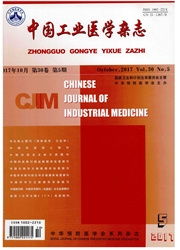

 中文摘要:
中文摘要:
目的探讨噪声暴露强度和累积噪声暴露量(cumulative noise exposure,CNE)对SOD2靶向定位序列rs4880单核苷酸多态性(single nucleotide polymorphisms,SNPs)与噪声性高频听力损失易感性关联的影响。方法利用病例对照研究,通过比较同一噪声暴露强度作业人员的左耳3000Hz频段听阚位移情况,筛选出听阈位移最大的10%个体作为本研究的易感人群组,共201例,听阈位移最小的10%个体作为耐受人群组,共202例,并进行相关的职业卫生调查和问卷调查。噪声暴露强度的检测根据《工作场所物理因素测量噪声》(GBZ/T189.8—2007),抽取易感人群和耐受人群空腹外周静脉血5ml用于常规方法抽提基因组DNA,TaqMan探针法化学荧光等位基因鉴别试验检测SNP。结果在噪声暴露强度85~92dB(A)组以及〉92dB(A)组,SOD2基因rs4880SNP与噪声性高频听力损失的患病风险有关,携带CC+CT基因型与Tr基因型相比OR值分别为2.38(1.27,4.46)和3.67(1.10,12.30)。CNE分层分析发现,CNE位于82~92dB(A)组时,SOD2基因rs4880SNP与噪声性高频听力损失的患病风险有关,携带CC+CT基因型与1Tr基因型相比,患噪声性高频听力损失的风险更高,OR值为2.59,95%C/为(1.14,5.90)。结论噪声暴露水平可影响SOD2靶向定位序列rs4880单核苷酸多态性与噪声性高频听力损失易感性的关联。
 英文摘要:
英文摘要:
Objective To observe the effect of noise exposure level on the association between rs4880 SNPs of SOD2 and noise-induced hearing loss. Methods A case-control study was used in the study. 201 noise exposed workers with maximal hearing threshold displacement and 202 noise exposed workers with minimal hearing threshold displacement were selected as sen- sitive objects and resisitant objects, respectively. The questionnaire was used for investigation including occupational risk fac- tors. Noise exposure level was detected by a Chinese National Standard: measurement of noise in the workplace (GBZ! T189. 8--2007 ). Genome DNA was extracted from peripheral blood ceils samples according to the standard procedures of Takara kit, SNPs were detected with TaqMan probe allele identification method. Results The results showed that in 85---92 dB(A) and 〉 92dB(A) noise exposure groups, the CC + CT genotype of rs4880 is a risk factor of noise induced high frequency hearing loss, OR=2.38, 95%(71 (1.27, 4.46) and OR=3.67, 95%CI (1.10, 12.30) compared with TT genotype. While in CNE 〉 82 dB(A), CC + CT genotype of rs4880 is a risk factor, OR = 2. 59, 95% CI ( 1.14, 5.90) compared with Tr genotype. Conclusion The results suggested that noise exposure level may influence the association between rs4880 SNP of SOD2 and noise induced high frequency hearing loss.
 同期刊论文项目
同期刊论文项目
 同项目期刊论文
同项目期刊论文
 期刊信息
期刊信息
